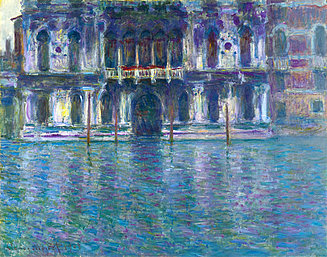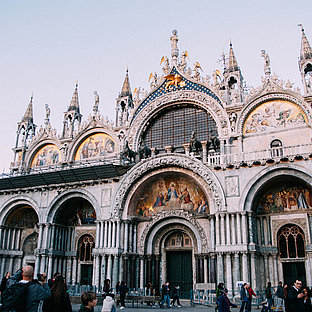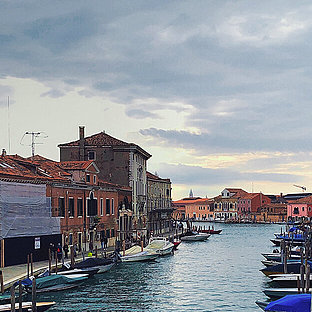Les Venise de Monet – Monet’s return to Venice
6 min readIn 1908, Claude Monet and his wife Alice spent some time in Venice.
He was so overwhelmed by La Serenissima that he deemed her too beautiful to be painted. However, he did create an entire series of works featuring architectural Venetian motifs – 37 paintings at 9 different places within 3 months.
Monet’s wife recorded the journey in daily letters to her daughter. While the painter depicted the famous water-lily pond in the garden of his house in Giverny by stretching it into a vertical position until the water completely filled the surface of his canvasses, his Venetian compositions play with the water’s depth and the frontality of the façades of various palazzi, including that of the Palazzo Contarini Polignac. It was here that Winnaretta Singer – the patron who had purchased the palazzo in 1900 – welcomed the Monets on 9 October 1908. In 2020, the palazzo has now been owned by the family for 120 years, a special anniversary and a legacy honoured by a special project. Bikem de Montebello is in charge of coordinating the project. She is married to Roger de Montebello, a descendent of a sister of Winnaretta Singer. The couple live permanently in the palazzo, with Bikem taking care of its conservation and scheduling events.
An exchange between Italy, France and Switzerland
The project ‘Les Venise de Monet’ is a video mapping of the works Monet created in Venice, including his painting of the Palazzo Contarini Polignac. The most important motif is the 15th century façade of this palazzo.The building is famous for its special Lombard style, which makes it one of the most significant buildings from the early Renaissance. Students from the Accademia di Belle Arti in Venice and the St. Gallen Design Academy will produce two videos for this purpose. The project should encourage other people as well as the students to think about the topic. The students are to produce an oeuvre which will encourage visitors to the Biennale to start thinking about the uniqueness of this subject and the exchange between the Venetian, Swiss and French cultures.
Metamorphosis of water and light
For decades Monet dedicated himself to reproducing reflections and complex water structures. In Venice, he combined architecture with water in this context – the motif itself becomes a reflection. That’s why for her graduation thesis the St. Gallen student Romina Schöni decided to revive the history of the Monets, and the architecture and reflections Monet portrayed. The water of Canal Grande captures the façade of the Palazzo Contarini Polignac and reflects Monet’s encounter with Venice. The projection dissolves the solid structures of the architecture. Light and water gradually transform the palazzo into a piece of canvas, where Monet’s paintings, text from the letters written by his wife and the composition of the façade's architecture become visible. Lines emerge from the water, pictures come into view and disappear, words vanish.
The Palazzo Contarini (built in around 1490) is one of the first Renaissance palazzi of Venice and thus marks the beginning of a new culture of architecture at that time. Although it is in no way inferior to the great Renaissance buildings of Pisa, Lucca and Florence, neither the name of the architect nor that of his client are known. Its decorative elements modelled on antique architecture, such as round arches, medallions, Ionic and Corinthian forms, columns and pillars resemble those found in the churches Santa Maria di Miracoli and San Zaccaria, which were built at about the same time by Pietro Lombardo and Mauro Codussi. It is certain that the stonemason Giovanni Antonio Buora who came from Lugano had a part in it. The three-storey building with well-balanced proportions has a façade divided by symmetrical axes and panelled with marble slabs.
A red band of porphyry generates an impressive contrast to the white marble consoles and a creates pronounced horizontal line. The magnificent Piano Nobile (the top floor) overlooks the Canal Grande via five arched windows flanked by columns. The decorated balcony parapet is framed by skirting with spirals while medallions made of red porphyry and green marble complete the sophisticated decoration. Two balustrades were added in the 17th century. On closer inspection, the perfectly balanced proportions are revealed as an A-B-A pattern, with the columns serving as vertical dividing lines. The lower register is divided into seven rectangular parts of equal size which contribute to the well-balanced symmetry.
Lecture: Monet then and now
Philippe Piguet (curator of the project) is a historian and an art critic, freelance curator and director of the programme for contemporary art at the Chapelle de la Visitation in Thonon-les-Bains, Haute Savoie. He collaborates with the magazines /art absolument/ and artpress. In January 2018, he was appointed curator-general of Normandie Impressionniste 2020. He is the author of numerous texts and catalogue presentations for artists such as Monet, César, Villeglé, Raynaud, Venet, Basquiat, Garouste and Penone. He is the author and director of various films and holds numerous lectures; his field of studies is the impressionist era, especially Claude Monet – whose great-great-grandson he has become by marriage – and the development of contemporary art since the 1950s. We spoke to Philippe Piguet.
The Venetian paintings from your great-great-grandfather are genuine treasures. How can the ‘Les Venise de Monet’ project do them justice?
Monet’s journey to Venice was originally intended as a pleasure trip to discover the city of the doges. He did not think for one moment that he would stay there for two-and-a-half months and leave with 37 paintings. But in Venice, he found the material he needed to explore the incredible interplay between water, light and architecture. The combination of these three elements with each other is what the relevance of this project is based on.
What is your personal view and your view as an art historian of this new interpretation?
The picture that comes to mind in connection with Monet is primarily that of a painting with water reflecting nature; here the painter endeavours to capture its continuous modulations occurring at different hours and on different days. Monet rarely chose architecture as his motif, except in his unique series about the Cathedral of Rouen. Venice gave him an opportunity to re-consider this kind of topic, and he was only too willing to do so, after having been completely absorbed by his water lilies for quite a number of years. This was a new challenge he was ready to meet.
Can you give us a little foretaste of your lecture at the Palazzo?
The idea of the presentation entitled ‘Claude Monet, Water, Light and Architecture’ is to clearly outline the reasons why Monet allowed himself to be captivated by Venice, and how he couldn’t resist, even though he had not gone there expressly to paint. At the same time, it must be pointed out that he created a number of paintings here which constitute a ‘continuation’ rather than a ‘series’.
Visualisations: Romina Schöni
Student project: Digital Monet
Marc Simonet (Project Leader, St. Gallen) is a student of Interactive Media Design at the St. Gallen School of Design at the GBS. The graphic designer, who has an additional qualification in photography and now 21 years of professional experience, plans and designs printed and digital communication media at his own agency. With his additional Interactive Media Design studies, he plans to move more deeply into the digital world to design top-quality products for his customers in this area as well. The project in Venice offers him, and of course the entire project group, a platform to present their skills to a wider public. Marc Simonet gave us a brief interview about the project.
How did the collaboration come about?
The St. Gallen School of Design was invited to join the project in Venice, because one of Monet’s paintings of the Palazzo Contarini Polignac is hanging in the St. Gallen Art Museum. The higher technical college course in communication design, specialising in interactive media design is ideal for this project. The students take the course as continuous professional development and therefore already have practical experience meaning they are able to face interesting digital design challenges.
How were the students selected?
Early in the planning phase it was already clear that this would be a digital project, so the ‘Interactive Media Design’ class taught by Jana Nobel and Alex Huldi at the College of Arts and Design was chosen, as it is ideal for this type of digital project. One of the students, Romina Schöni, has now decided to dedicate her graduation thesis to this project.
How did the architecture of the Palazzo Contarini Polignac come to be included in this project?
One of the requirements was that the project should include the façade of the palazzo. The pictures painted and letters written by Claude and Alice Monet during their stay in Venice in 1908 should also be shown. It should also be clear that there will be a topic which goes beyond all of this. ‘Les Venise de Monet’ – to show his way of making reflections and complex structures of water merge with the architecture. An important aspect in both nature and architecture is the golden ratio, which also dominates the design of the palazzo’s façade. For example, the Fibonacci spiral slowly emerges from the water in one projection. A metamorphosis consisting of water, light, picture and architecture is to be created, similar to that in the painting.




